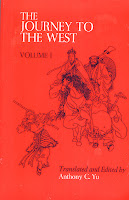 Author: Cheng’en Wu
Author: Cheng’en Wu
Translator: Anthony C. Yu
U.S. publisher: University of Chicago Press
ISBN: 9780226971476
Released: February 1980
Original release: 16th century
The Journey to the West is a highly influential work written anonymously in China during the Ming Dynasty in the 1590s. Believed to be written by Cheng’en Wu, it is considered to be one of the Four Great Classical Novels of China. The Journey to the West is a fictionalization of the historical journey from China to India undertaken by the Buddhist monk Xuanzang and incorporates numerous folk tales, myths, and legends. The Journey to the West has been and continues to be the inspiration for seemingly countless works and adaptations not only in China, but in Japan (where it is known as Saiyuki) and all over the rest of the world as well. The first complete and unabridged English edition of the the original The Journey to the West, including the integral poetry, was translated by Anthony C. Yu. The Chicago University Press published Yu’s translation in four volumes between 1977 and 1983. An abridged version of Yu’s translation is also available under the title The Monkey and the Monk.
In its entirety, The Journey to the West is one hundred chapters. The first volume of Yu’s translations consists of the first twenty-five chapters, a very useful and informative preface and introduction, and plenty of helpful end notes. The first seven chapters tell the story of Sun Wukong, the Monkey King, following his birth, education, disruption of Heaven, and his eventual imprisonment under a mountain. Monkey’s tale is the part of The Journey to the West with which I was already most familiar. The Journey to the West continues with the circumstances surrounding the journey as well as the backgrounds of our intrepid monk Tripitaka and the other companions that will end up joining him in addition to Monkey. The actual journey—Tripitaka’s travels to retrieve sacred scriptures from the West—doesn’t begin until chapter thirteen.
I didn’t know it before I read the first volume of Yu’s translations of The Journey to the West, but the Bodhisattva Kuan-yin plays a significant role in the story. For various reasons, Kuan-yin happens to be my favorite member in all of the Buddhist pantheons, so it made me happy to find her in The Journey to the West. Tripitaka, on the other hand, I found somewhat frustrating as a character. Once his journey begins it seems as if the only thing he can do is faint in fear and fall off his horse when confronted with monsters and demons. Granted, this is a fairly reasonable reaction give the circumstances. But what Tripitaka lacks in stamina and valor, he more than makes up for in stupendous moral and spiritual integrity. He’s not afraid to give Monkey and the rest of his companions brilliant tongue-lashings when the situation calls for it.
With a marvelous mix of magic, martial arts, mischief, and mayhem, The Journey to the West is a tremendous amount of fun. It is easy to see why the story is so loved and has inspired so many adaptations. And while The Journey to the West has some tragic elements to it, it is also a very funny story with plenty of humor to enjoy. Although I have not read any other translations of The Journey to the West to compare it to, I am so far happy with Yu’s translation. Some of the terms and phrases may be unfamiliar due to cultural differences, but like the original, Yu uses approachable, commonplace language. The text itself is somewhat repetitive, frequently reusing descriptions and constantly reiterating plot developments. But even considering this, The Journey to the West is immensely entertaining and I look forward to reading the rest of Yu’s translation.
Leave a Reply